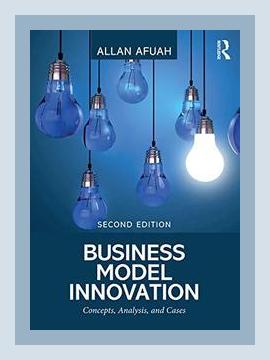Innovation and CreativityBusiness Model Innovation
**
Introduction
Allan Afuah’s book “Business Model Innovation: Concepts, Analysis, and Cases” offers an in-depth analysis of the concepts, methodologies, and practical applications of business model innovation (BMI). Afuah dissects how businesses can innovate their models to develop a competitive edge and sustain growth in a rapidly evolving market. The book is structured to provide theoretical insights and real-world case studies, balanced with actionable recommendations for practitioners.
Chapter 1: Understanding Business Models
Afuah starts by defining a business model as a framework that details how a company creates, delivers, and captures value. Core components include value proposition, revenue model, target customer segments, and cost structure.
Actionable Insight:
– Map out your current business model using the Business Model Canvas. Identify each component and highlight areas needing innovation.
Chapter 2: The Evolution of Business Models
The author emphasizes the dynamic nature of business models, tracing their evolution over decades. Examples like Apple’s shift from a computer manufacturer to a digital service provider illustrate the need for continuous reassessment.
Example:
– Apple’s transition from selling only hardware to offering services like iTunes and the App Store shows the adaptation of its business model over time.
Actionable Insight:
– Periodically review your business model considering market trends and technological advancements. Facilitate brainstorming sessions to identify potential pivots.
Chapter 3: Drivers of Business Model Innovation
Afuah identifies five primary drivers of BMI: technological changes, socio-economic trends, regulatory shifts, competitive pressures, and market needs. Each driver provides opportunities for redefining business models.
Example:
– Uber’s success is driven by technological advancements in mobile internet and GPS, coupled with changing consumer behaviors toward shared economy services.
Actionable Insight:
– Conduct a PEST analysis (Political, Economic, Social, Technological) to identify external drivers that could inspire innovative adjustments to your business model.
Chapter 4: Types of Business Model Innovation
The book categorizes BMI into four broad types: industry models, revenue models, enterprise models, and channel models. Afuah uses specific examples to contextualize each type.
Example:
– Netflix transformed the entertainment industry model from DVD rentals to streaming services, creating a disruptive effect.
Actionable Insight:
– Identify which type of business model innovation is most applicable to your company. Then, conceptualize experiments or pilot projects to test new models.
Chapter 5: Frameworks and Methodologies
Afuah discusses various frameworks and methodologies for pursuing BMI, including the use of design thinking, lean startup approaches, and value network analysis.
Example:
– Airbnb used the lean startup method to test and validate its home-sharing concept before scaling.
Actionable Insight:
– Adopt a lean startup approach by building Minimum Viable Products (MVPs) to test your innovative concepts and gather user feedback quickly.
Chapter 6: Overcoming Barriers to Business Model Innovation
The book highlights common barriers to BMI, such as organizational inertia, risk aversion, and resource constraints, offering strategies to overcome them.
Example:
– Kodak failed to innovate its business model despite having early access to digital camera technology due to organizational inertia and a fixation on traditional film.
Actionable Insight:
– Establish a culture that embraces experimentation and risk-taking, possibly by setting up an innovation lab separate from the core business.
Chapter 7: Case Studies of Business Model Innovation
Afuah provides multiple in-depth case studies from various industries to illustrate successful and failed BMI attempts. Each case study offers lessons on the critical factors that contributed to the outcomes.
Example:
– IBM’s transformation from a hardware-focused company to a consulting and services firm showed how BMI could pivot a company into new, profitable directions.
Actionable Insight:
– Study and learn from industry leaders and their strategic pivots. Implement regular competitive analysis to stay informed about industry trends and best practices.
Chapter 8: Measuring the Impact of Business Model Innovation
This chapter deals with metrics and KPIs to measure the effectiveness of business model innovations. Metrics like customer acquisition cost, customer lifetime value, and innovation ROI are essential for analysis.
Example:
– Amazon tracks extensive customer data to continuously refine its business model, focusing on customer acquisition and retention metrics.
Actionable Insight:
– Develop a dashboard of relevant metrics tailored to your business model. Regularly review these metrics to gauge the success of your innovation efforts.
Chapter 9: Strategic Leadership in Business Model Innovation
Afuah outlines the role of leadership in driving business model innovation within organizations. Leaders must craft a vision, allocate resources, and foster an innovative culture.
Example:
– Elon Musk’s ability to articulate and pursue ambitious visions for Tesla and SpaceX has been pivotal in challenging and transforming industry norms.
Actionable Insight:
– Build a clear vision for your organization with a strong emphasis on innovation. Communicate this vision effectively to mobilize your team and stakeholders.
Chapter 10: Implementing Business Model Innovation
Practical insights into the implementation process of BMI are provided, including stakeholder engagement, pilot testing, scaling innovations, and iteration based on feedback.
Example:
– Google’s continuous iteration and feedback loop system known as “20% time” encourage employees to spend 20% of their time working on innovative projects.
Actionable Insight:
– Create structured phases for implementing business model innovations, with each phase including specific milestones and feedback mechanisms.
Conclusion
In “Business Model Innovation: Concepts, Analysis, and Cases,” Allan Afuah furnishes readers with a comprehensive toolkit for understanding and applying business model innovation. The strategic insights and practical examples serve as a guide for leaders and practitioners aiming to transform their business models to stay competitive in changing markets. By empowering readers with actionable strategies, Afuah’s work ensures that businesses can adapt and thrive through continuous innovation.
